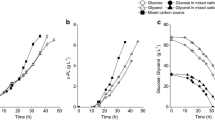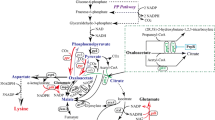Abstract
The glucose–glycerol mixed carbon source remarkably reduced the batch fermentation time of ε-poly-l-lysine (ε-PL) production, leading to higher productivity of both biomass and ε-PL, which was of great significance in industrial microbial fermentation. Our previous study confirmed the positive influence of fast cell growth on the ε-PL biosynthesis, while the direct influence of mixed carbon source on ε-PL production was still unknown. In this work, chemostat culture was employed to study the capacity of ε-PL biosynthesis in different carbon sources at a same dilution rate of 0.05 h−1. The results indicated that the mixed carbon source could enhance the ε-PL productivity besides the rapid cell growth. Analysis of key enzymes demonstrated that the activities of phosphoenolpyruvate carboxylase, citrate synthase, aspartokinase and ε-PL synthetase were all increased in chemostat culture with the mixed carbon source. In addition, the carbon fluxes were also improved in the mixed carbon source in terms of tricarboxylic acid cycle, anaplerotic and diaminopimelate pathway. Moreover, the mixed carbon source also accelerated the energy metabolism, leading to higher levels of energy charge and NADH/NAD+ ratio. The overall improvements of primary metabolism in chemostat culture with glucose–glycerol combination provided sufficient carbon skeletons and ATP for ε-PL biosynthesis. Therefore, the significantly higher ε-PL productivity in the mixed carbon source was a combined effect of both superior substrate group and rapid cell growth.




Similar content being viewed by others
References
Hiraki J, Ichikawa T, Ninomiya S, Seki H, Uohama K, Seki H, Kimura S, Yanagimoto Y, Barnett JJ (2003) Use of ADME studies to confirm the safety of ε-polylysine as a preservative in food. Regul Toxicol Pharm 37:328–340
Shih IL, Shen MH, Van YT (2006) Microbial synthesis of poly(epsilon–lysine) and its various applications. Bioresour Technol 97(9):1148–1159
Bankar SB, Singhal RS (2013) Panorama of poly-ε-lysine. RSC Adv 3(23):8586–8603
Li S, Tang L, Chen X, Liao L, Li F, Mao Z (2011) Isolation and characterization of a novel epsilon-poly-l-lysine producing strain: Streptomyces griseofuscus. J Ind Microbiol Biot 38(4):557–563
Jia S, Wang G, Sun Y, Tan Z (2009) Improvement of ε-poly-l-lysine production by Streptomyces albulus TUST2 employing a feeding strategy. Paper presented at the Tian** University of Science and Technology, Tian**, China
Bankar SB, Singhal RS (2010) Optimization of poly-epsilon-lysine production by Streptomyces noursei NRRL 5126. Bioresour Technol 101(21):8370–8375
Chen XS, Tang L, Li S, Liao LJ, Zhang JH, Mao ZG (2011) Optimization of medium for enhancement of epsilon-poly-l-lysine production by Streptomyces sp. M-Z18 with glycerol as carbon source. Bioresour Technol 102(2):1727–1732
Kahar P, Iwata T, Hiraki J, Park EY, Okabe M (2001) Enhancement of ε-polylysine production by Streptomyces albulus strain 410 using pH control. J Biosci Bioeng 91(2):190–194
Chen XS, Ren XD, Dong N, Li S, Li F, Zhao FL, Tang L, Zhang JH, Mao ZG (2012) Culture medium containing glucose and glycerol as a mixed carbon source improves ε-poly-l-lysine production by Streptomyces sp. M-Z18. Bioproc Biosyst Eng 35(3):469–475
Liu Y, Zhang YG, Zhang RB, Zhang F, Zhu J (2011) Glycerol/glucose co-fermentation: one more proficient process to produce propionic acid by Propionibacterium acidipropionici. Curr Microbiol 62(1):152–158
Kim YS, Lee JH, Kim NH, Yeom SJ, Kim SW, Oh DK (2011) Increase of lycopene production by supplementing auxiliary carbon sources in metabolically engineered Escherichia coli. Appl Microbiol Biot 90(2):489–497
Peacock L, Ward J, Ratledge C, Dickinson F, Ison A (2003) How Streptomyces lividans uses oils and sugars as mixed substrates? Enzyme Microb Tech 1:157–166
Zeng X, Chen XS, Ren XD, Liu QR, Wang L, Sun QX, Tang L, Mao ZG (2014) Insights into the role of glucose and glycerol as a mixed carbon source in the improvement of ε-poly-l-lysine productivity. Appl Biochem Biotech 173(8):2211–2224
Zeng X, Chen X, Ren X, Wang L, Gao Y, Mao Z (2016) Improved ε-poly-l-lysine productivity partly resulting from rapid cell growth in cultures using a glucose–glycerol mixed carbon source. Eng Life Sci 16:443–452
Vázquez-Lima F, Silva P, Barreiro A, Martínez-Moreno R, Morales P, Quirós M, González R, Albiol J, Ferrer P (2014) Use of chemostat cultures mimicking different phases of wine fermentations as a tool for quantitative physiological analysis. Microb Cell Fact 13:85
Gallmetzer M, Burgstaller W (2001) Citrate efflux in glucose-limited and glucose-sufficient chemostat culture of Penicillium simplicissium. Antonie Van Leeuwenhoek 79(1):81–87
Pim VH, Johannes PVD, Jack TP (1998) Effect of specific growth rate on fermentative capacity of baker’s yeast. Appl Environ Microb 64:4226–4233
Nishikawa MOK (2002) Distribution of microbes producing antimicrobial ε-poly-l-lysine polymers in soil microflora determined by a novel method. Appl Environ Microb 68(7):3575–3581
Fountoulakis M, Lahm HW (1998) Hydrolysis and amino acid composition analysis of proteins. J Chromatogr A 826(2):109–134
Zhu Y, Rinzema A, Bonarius H, Tramper J, Bol J (1998) Microbial transglutaminase production by Streptoverticillium mobaraense: analysis of amino acid metabolism using mass balances. Enzyme Microb Tech 23(3):216–226
Chen XS, Mao ZG (2013) Comparison of glucose and glycerol as carbon sources for epsilon-poly-l-lysine production by Streptomyces sp. M-Z18. Appl Biochem Biotech 170(1):185–197
Yamanaka K, Maruyama C, Takagi H, Hamano Y (2008) Epsilon-poly-l-lysine dispersity is controlled by a highly unusual nonribosomal peptide synthetase. Nat Chem Biol 4(12):766–772
Yamanaka K, Kito N, Imokawa Y, Maruyama C, Utagawa T, Hamano Y (2010) Mechanism of epsilon-poly-l-lysine production and accumulation revealed by identification and analysis of an epsilon-poly-l-lysine-degrading enzyme. Appl Environ Microb 76(17):5669–5675
VanBriesen JM (2002) Evaluation of methods to predict bacterial yield using thermodynamics. Biodegradation 13:171–190
Acknowledgements
This work was financially supported by the National Natural Science Foundation of China (31671846, 31301556), the Science and Technology Department of Jiangsu Province (BY2016022-25), the Fundamental Research Funds for the Central Universities (JUSRP51504), the Open Project Program of the Key Laboratory of Industrial Biotechnology, Ministry of Education, China (KLIBKF201302), and the Jiangsu Province Collaborative Innovation Center for Advanced Industrial Fermentation Industry Development Program.
Author information
Authors and Affiliations
Corresponding author
Ethics declarations
Conflict of interest
The authors declare that they have no conflict of interest.
Electronic supplementary material
Below is the link to the electronic supplementary material.
Rights and permissions
About this article
Cite this article
Zhang, JH., Zeng, X., Chen, XS. et al. Metabolic analyses of the improved ε-poly-l-lysine productivity using a glucose–glycerol mixed carbon source in chemostat cultures. Bioprocess Biosyst Eng 41, 1143–1151 (2018). https://doi.org/10.1007/s00449-018-1943-y
Received:
Accepted:
Published:
Issue Date:
DOI: https://doi.org/10.1007/s00449-018-1943-y




